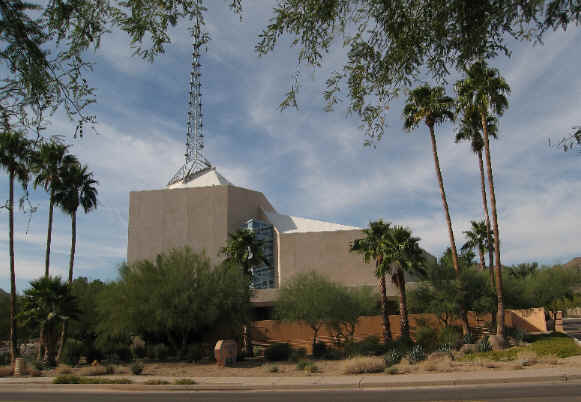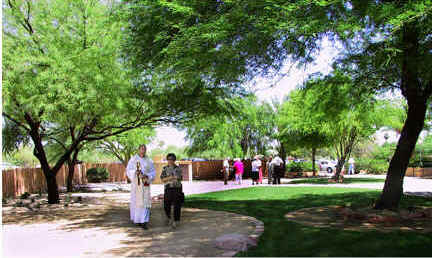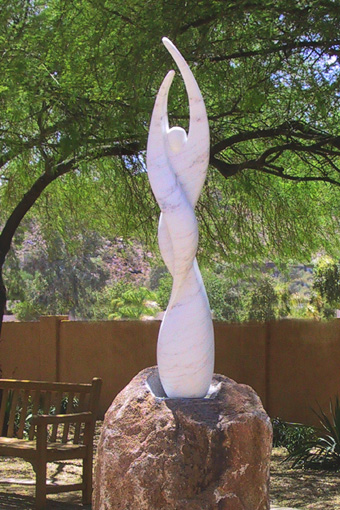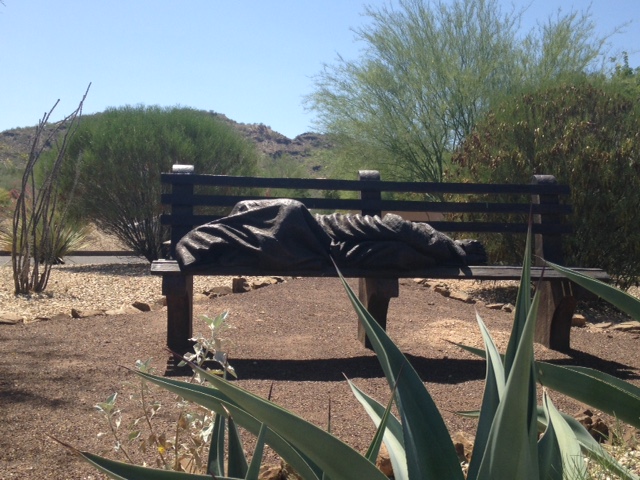Church Campus

The Ascension Lutheran Church Campus is located ½ mile west of Scottsdale Road and ½ mile north of Lincoln Drive in Paradise Valley, Arizona.
The Architecture
The Ascension sanctuary and facility is significantly influenced by the Organic Architecture of Frank Lloyd Wright and Taliesin West. Mr. Wright’s son-in law, Wesley Peters, was the architect of record. Mr. Peters incorporated the pentagon into the design of the building internally and externally. The pentagon points to Pentecost, which was the birthday of the Christian church, when the Holy Spirit was given to all believers.
William Wesley Peters
June 12, 1912 – July 17, 1991
We at Ascension know William Wesley Peters through his architecture. We feel God’s presence in this space and appreciate the symbolism of his geometric shape of the pentagon, but Wesley was more than an architect of one building. He was an architect of many buildings, a respected member of the Taliesin Community, and a fine human being.
Wes, as he came to be known, grew up in southern Indiana. He was born in Terre Haute to Clara Margredant Peters and Frederick Romer Peters, newspaper editor. He graduated from high school in Evansville and attended Evansville College from 1927-30 and MIT from 1930-31. In 1932 he became the first apprentice in Frank Lloyd Wright’s Fellowship. At MIT he was trained as an engineer and as an architect at Taliesin.
He did the engineering calculations for Frank Lloyd Wright’s designs of Fallingwater, the Guggenheim Museum, the Johnson Wax Complex, the First Unitarian Meeting House in Madison, WI, the Greek Orthodox Church of the Annunciation in Wauwatosa and any number of other major buildings and private homes. Richard Carney, CEO of the FLW Foundation, said, “Wes provided the engineering that made many of Mr. Wright’s buildings possible and Mr. Wright inspired Wes to reach beyond anything he could have achieved alone. Each was richer because of the association with the other.”
William Wesley Peters had his own style of architecture. He could be dramatic and glamorous as in the opulent Pearl Palace which he designed for the sister of the Shah of Iran or intimate and warm as in many modestly scaled private homes. He was a registered architect in 50 states, Guam, and the United Kingdom. He designed more than 120 projects including 7 places of worship.
On a personal note, Wes married Frank Lloyd Wright’s adopted daughter Svetlana in 1935. They had 2 sons: Daniel and Brandoch. In 1946 his wife, son Daniel, and unborn child were tragically killed in an automobile accident in Wisconsin. Wesley accepted his responsibility for rearing Brandoch. He and Brandoch lived in a three-room apartment at Taliesin West and a slightly larger one at Taliesin. Brandoch continues to live on the farm his father once owned in Wisconsin where they raised thoroughbred cattle. Wesley Peters married a second time in 1970 to Stalin’s daughter, Svetlana Aliluyeva. They knew each other for 22 days prior to the wedding and separated 20 months later. This union produced a daughter, Olga Peters Evans. At the time of Wesley’s death, she was living in London.
William Wesley Peter’s sister was Margedant Hayakawa whose husband was S. I. Hayakawa, noted General Semanticist and U.S. Senator from California. Wesley designed their house remodeling project which was featured in the June 1961 issue of House Beautiful.
Wesley wrote thirty professional articles and a chapter in a book about Frank Lloyd Wright. He was recognized throughout the architectural community, and in 1963 received the Missouri Association of Registered Architects Award. Mr. Peters was given three honorary PhD. Degrees. In 1971 Evansville College presented him with an Honorary Doctor of Science. In 1973 Centre College of Kentucky presented him with an Honorary Doctor of Fine Arts, and in 1989 Florida Southern College presented him with an Honorary Doctor of Architecture.
Wes’s heart was never far from Taliesin. He wore two watches; one set for Taliesin time and the other set for the place he happened to be. He always played an important role in the Taliesin Fellowship. From 1940-59 he was the Secretary of the Frank Lloyd Wright Foundation; in 1959 when Mr. Wright passed away he became the chief architect and vice-president for Taliesin Associated Architects; in 1985 when Mrs. Wright passed away, he became the Chairman of the Board of the Frank Lloyd Foundation. At the time of his passing he held the titles of Chairman of the Board, Vice President, and Chief Architect of Taliesin Associated Architects.
William Wesley Peters, from all accounts, was a special human being. In a feature article in a Wisconsin newspaper, The Capital Times, he is described in this manner: ” He reads extensively and is regarded as one of the best informed men anywhere.” His interests include sleek ships, fast cars, scientific farming, military history, rare coins, and Indian rugs. He was described as a chess player of tournament caliber. Vern Swaback, one of Wright apprentices and successful architect in Arizona, described Wes as “simply the most generous, selfless man I have ever known. He retained the playful soul of youth, seemingly undiminished by the sufferings of life, of which he endured far more than his share. I don’t think it would have been possible for Wes to intentionally hurt anyone. He wouldn’t have known how to do so.” E.R. Ronald, Jr., a consulting engineer who had worked with Wes on a number of projects, describes Wes as having a virtue of humility. “He seemed to treat everyone the same, on an equal basis-whether it would be the janitor in the building or the president. He always had time for them and answered their questions. His enthusiasm was infectious. It was fun- to be around him” Many other describe him as unfailingly polite, optimistic, enthusiastic, and generous.
We at Ascension thank William Wesley Peters for being the kind, generous renaissance man with the ability to design a quality building for us which can be enjoyed for generations.
Excerpts from a message sent by architect William Wesley Peters to Ascension Lutheran on its dedication in 1964
‘The plan for the fully developed Ascension Lutheran Church building is based on three elemental geometric forms: the Pentagon, the Circle, and the Straight Line. The ground plan involves an interrupted circular form intersecting a pentagon. The Pentagon is singularly adapted to serve as the basic form for a church or auditorium. It is closely related in geometric structure to the five-pointed star – the star of Bethlehem, or traditionally the “Epiphany” Star. Practically, the form provides wall surfaces that converge on the worship center, allowing a large central area with excellent visual and acoustical characteristics. The Circle traditionally symbolizes Infinity or Eternity, being, in its completed form, without beginning or end. The Straight Line has been symbolically associated with extension, projection, direction, and achieved purpose. The design of the Sanctuary seeks to exemplify the essential character of the Lutheran faith, every part designed in relation to and culminating in the focal point of the cross which represents the direct meeting of God and Man in Christ.”
Memorial Garden and Columbarium

 ASCENSION’S FIRST MEMORIAL GARDEN SCULPTURE was dedicated on Ascension Sunday, May 12, 2002. This graceful work of art, sculpted by local artist Jon DeCelles from white marble with silver-grey veins, sits on a boulder especially selected to serve as its pedestal. Titled “Ascension”, the work symbolizes Christ ascending into Heaven and serves as a reminder that our loved ones have also ascended into Heaven to be with God for eternity. The piece was commissioned as a memorial for Tom Doench by the Doench family. For more detail about the installation of this statue, click here.
ASCENSION’S FIRST MEMORIAL GARDEN SCULPTURE was dedicated on Ascension Sunday, May 12, 2002. This graceful work of art, sculpted by local artist Jon DeCelles from white marble with silver-grey veins, sits on a boulder especially selected to serve as its pedestal. Titled “Ascension”, the work symbolizes Christ ascending into Heaven and serves as a reminder that our loved ones have also ascended into Heaven to be with God for eternity. The piece was commissioned as a memorial for Tom Doench by the Doench family. For more detail about the installation of this statue, click here.
Ascension Lutheran Church is Metro Phoenix Exclusive Home for “Homeless Jesus”

On Sunday, November 23, 2014, Ascension Lutheran Church unveiled a life-size bronze sculpture titled “Homeless Jesus” with a community dedication, hoping that this life-size bronze sculpture will inspire spiritual reflection and human compassion within our community.
Created by Canadian sculptor Timothy P. Schmalz out of bronze, Homeless Jesus is inspired by Matthew 25:40- “Truly I tell you, whatever you did for one of the least of these brothers and sisters of mine, you did for me.” The sculpture is a representation that suggests Christ is with the most marginalized in our society. The Christ figure is shrouded in a blanket. The visible wounds on the feet are the only indication that it is Jesus. The life-size version of the work has enough room that someone is able to sit on the bench.
“The sculpture is an invitation to everyone – church-goers and non-church goers, to be part of a community that cares for one another,” says Reverend Ryan Hersch, pastor of Ascension. “This statue is for all of us.”
Ascension is the exclusive location for the sculpture in Phoenix; currently, four other major markets worldwide also have a sculpture. The sculpture’s powerful image, intended to elicit compassion, reflection and un-ease amongst onlookers has sparked controversy in other cities. In 2013, Pope Francis blessed the original wooden statue of Homeless Jesus, following a meeting with the artist. The wooden statue will remain in the Vatican until a location for the full-size sculpture is identified in Rome.
“Homeless Jesus sitting there on a park bench is speaking with an invisible loudspeaker to all who pass by, saying ‘Come and sit awhile with me, talk to me. I understand and I am walking with you through all the trials of your life’,” says Deacon Jayne Baker of Ascension. “The sculpture speaks volumes, without saying a word.”
Miniature statues are available for purchase through Ascension, with all proceeds to directly benefit the church’s outreach to ministries serving the homeless. Click here for our online store.
The church installed a new water station in close proximity to Homeless Jesus to welcome the many hikers and bikers that use Mockingbird Lane regularly.

